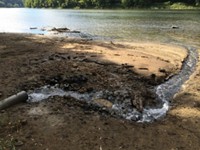Advertisement
Grab your lab coat. Let's get started
Welcome!
Welcome!
Create an account below to get 6 C&EN articles per month, receive newsletters and more - all free.
It seems this is your first time logging in online. Please enter the following information to continue.
As an ACS member you automatically get access to this site. All we need is few more details to create your reading experience.
Not you? Sign in with a different account.
Not you? Sign in with a different account.
ERROR 1
ERROR 1
ERROR 2
ERROR 2
ERROR 2
ERROR 2
ERROR 2
Password and Confirm password must match.
If you have an ACS member number, please enter it here so we can link this account to your membership. (optional)
ERROR 2
ACS values your privacy. By submitting your information, you are gaining access to C&EN and subscribing to our weekly newsletter. We use the information you provide to make your reading experience better, and we will never sell your data to third party members.
Environment
Coal Ash Spill In Tennessee Still A Problem
Environmental Disaster: High levels of arsenic linger downstream of the site of a 2008 accident
by Charles Schmidt
December 6, 2010
| A version of this story appeared in
Volume 88, Issue 49

Nearly two years ago, 978,000,000 gallons of wet coal ash spilled into the Emory River and its tributaries near Kingston, Tenn. Now researchers from Duke University report that the spill polluted downstream sediments with unexpectedly high levels of a particularly toxic form of arsenic (Environ. Sci. Technol., DOI: 10.1021/es1026739).
The spill occurred on Dec. 22, 2008, when a holding pond ruptured, releasing its waste from the Tennessee Valley Authority's Kingston Fossil Plant, a coal-fired power plant. Ash produced by burning coal isn't regulated as hazardous waste by the Environmental Protection Agency, because the EPA's testing protocol—known as the Toxicity Characterization Leaching Protocol—assumes that coal ash contaminants do not seep from municipal landfills into nearby water. The TVA spill provided a useful—if tragic—opportunity to test this assumption, says Duke geochemist Avner Vengosh: "It became a huge field experiment."
Soon after the accident, Vengosh and his colleagues descended on the site and launched an investigation that continues today into how the coal ash has affected the river's ecosystems.
For their current report, the team collected over 220 surface water and sediment samples during an 18-month period of TVA's clean up. They measured concentrations of five leachable coal ash contaminants, including arsenic and selenium. The researchers found that anaerobic bacteria in the sediments produce conditions that reduce arsenic from the common pentavalent form to the more-toxic trivalent form, As3+. Meanwhile, selenium leeches out of these anoxic sediments and migrates to the more-oxygenated surface water.
EPA's testing protocol does not predict these findings because it does not consider redox chemistry, explained co-author Helen Hsu-Kim: "The test is only concerned with acid-induced leaching." So it underestimates risks from arsenic under anaerobic disposal conditions, Vengosh says.

The team detected the highest contaminant levels near the spill site in a cove, which received a flowing waste stream during the spill. Given its isolation from the rest of the river, this cove concentrated ash pollutants, whereas in downstream areas with more water exchange, pollutant levels were more diluted. While surface water concentrations of selenium were high only in the cove, As3+ levels were high in sediments throughout the 300-acre spill site and surrounding watershed, Vengosh says.
The team also examined the effects of TVA's clean-up methods. Some experts feared that TVA's dredging of nearly two-thirds of the spilled ash would increase surface water contamination. The researchers saw no evidence of such a spike. But even after the remediation, buried ash in some locations still contaminates water among river sediments at arsenic levels beyond 2,000 ppb. In comparison, EPA's maximum contaminant level for arsenic in drinking water is 10 ppb.
EPA is considering whether to designate coal ash as hazardous waste and the Duke team's data are sure to influence that decision, says James Hower, a senior scientist at the University of Kentucky's Center for Applied Energy Research. But designating coal ash as hazardous waste might generate unwanted consequences, he says. For example, it could hamper use of coal ash as filler in concrete production. "There's no doubt these findings are damaging to the coal industry," he says.





Join the conversation
Contact the reporter
Submit a Letter to the Editor for publication
Engage with us on Twitter